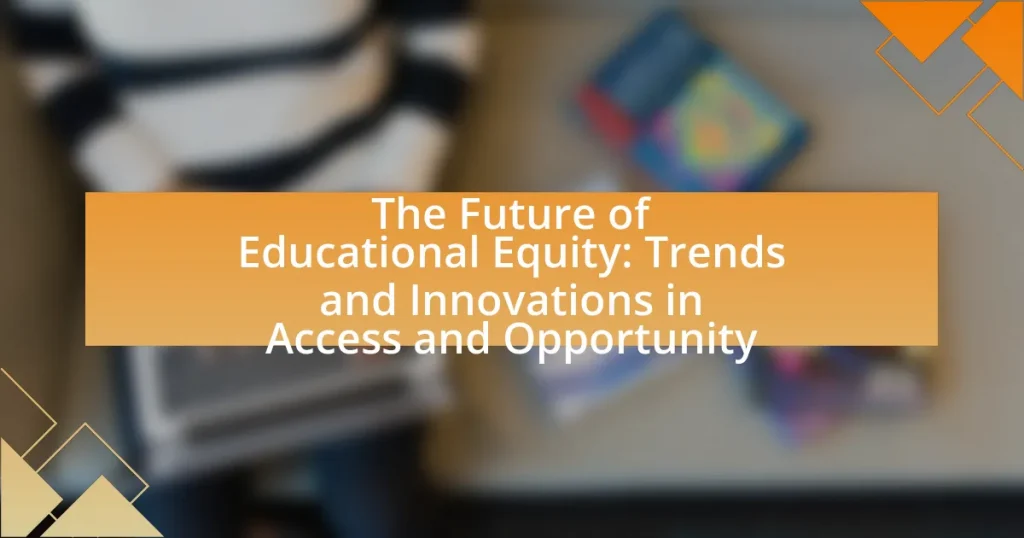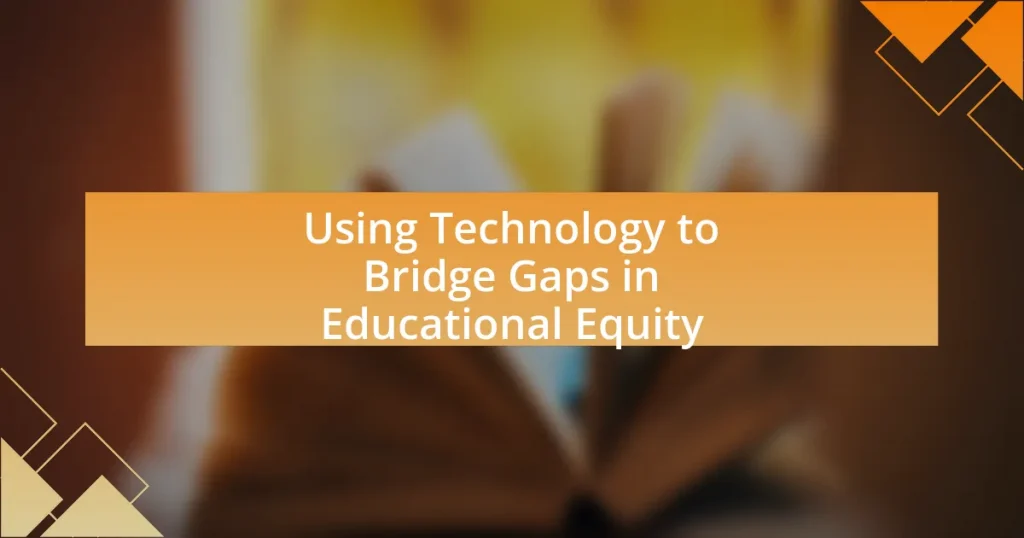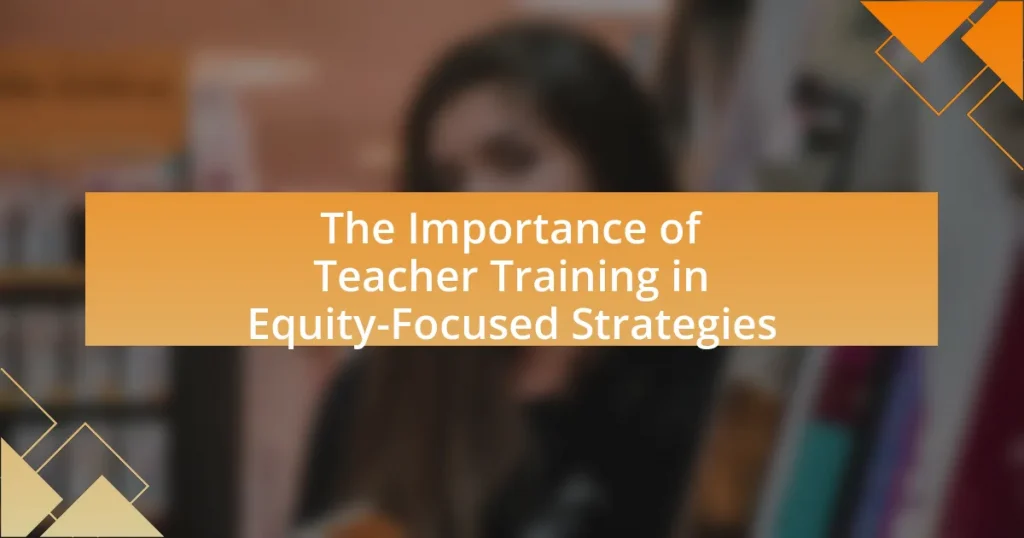The article focuses on the future of educational equity, emphasizing the importance of technology and policy reforms in ensuring equal access to quality education for all students. It defines educational equity as the principle that all students should have access to high-quality educational opportunities, regardless of their background, and outlines key principles such as access, participation, and outcomes. The article discusses the distinction between educational equity and equality, the significance of equitable education for societal growth, and the impact of current trends like personalized learning and community initiatives. Additionally, it addresses the challenges faced by marginalized groups and highlights best practices for fostering educational equity in the future.
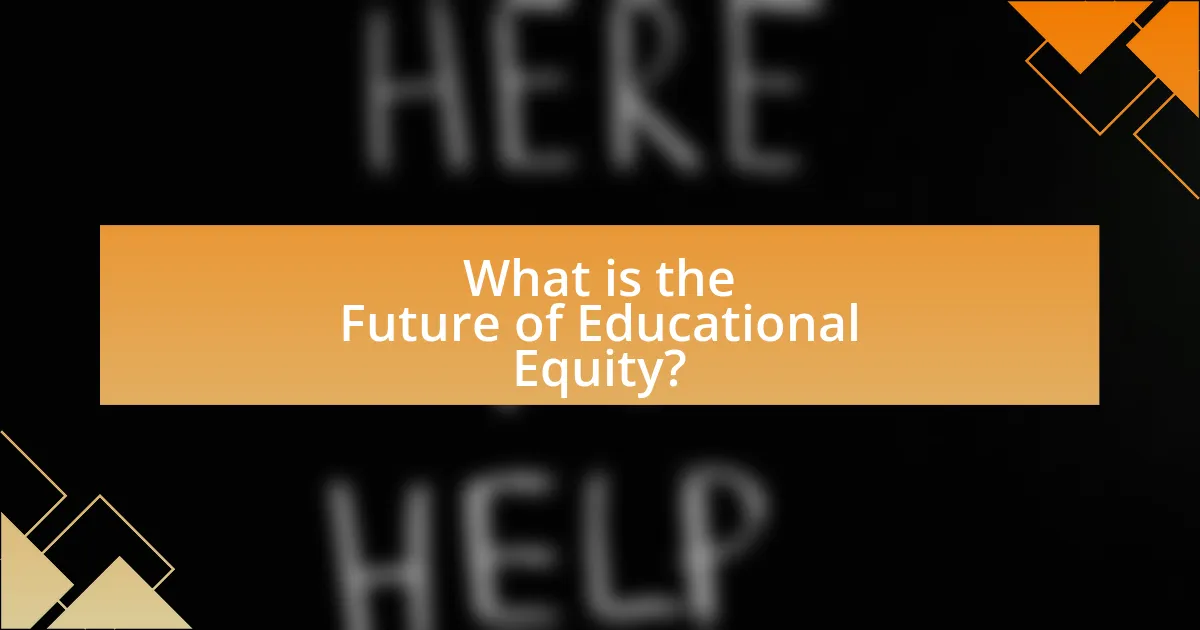
What is the Future of Educational Equity?
The future of educational equity is increasingly focused on leveraging technology and policy reforms to ensure equal access to quality education for all students. Innovations such as personalized learning platforms, online resources, and data-driven decision-making are being implemented to address disparities in educational outcomes. For instance, a report by the Brookings Institution highlights that technology can bridge gaps by providing tailored educational experiences that cater to individual learning needs, particularly for underserved populations. Additionally, policies aimed at increasing funding for low-income schools and promoting inclusive curricula are essential for fostering an equitable educational landscape. These trends indicate a commitment to dismantling systemic barriers and enhancing opportunities for every learner, regardless of their background.
How is educational equity defined in contemporary contexts?
Educational equity in contemporary contexts is defined as the principle that all students, regardless of their background, should have access to the same high-quality educational opportunities and resources. This definition emphasizes the need to address systemic barriers that contribute to disparities in educational outcomes, such as socioeconomic status, race, and geographic location. Research indicates that equitable education involves not only equal access to resources but also the provision of tailored support to meet diverse student needs, as highlighted in the 2020 report by the National Center for Education Statistics, which shows significant achievement gaps among different demographic groups.
What are the key principles underlying educational equity?
The key principles underlying educational equity include access, participation, and outcomes. Access ensures that all students have the necessary resources and opportunities to engage in education, regardless of their background. Participation emphasizes the importance of inclusive practices that allow diverse student voices and experiences to be represented in the educational process. Outcomes focus on achieving equitable results for all students, meaning that educational systems should strive to eliminate disparities in academic achievement and opportunities for advancement. These principles are supported by research indicating that equitable educational practices lead to improved student performance and social mobility, as highlighted in studies by the National Center for Education Statistics, which show that equitable access to quality education significantly impacts long-term success.
How does educational equity differ from equality in education?
Educational equity focuses on providing individualized resources and support to ensure all students achieve similar outcomes, while equality in education emphasizes providing the same resources to all students regardless of their individual needs. For instance, educational equity recognizes that students from disadvantaged backgrounds may require additional support, such as tutoring or mentoring, to reach the same academic level as their peers. In contrast, equality would mean giving every student the same textbook or classroom materials, which may not address the unique challenges faced by some students. This distinction is crucial in addressing systemic disparities in educational outcomes, as highlighted by research from the National Center for Education Statistics, which shows that students from low-income families often perform below their peers due to a lack of access to necessary resources.
Why is educational equity important for society?
Educational equity is crucial for society because it ensures that all individuals have access to quality education, regardless of their background or circumstances. This access promotes social mobility, reduces inequality, and fosters a more informed and engaged citizenry. Research indicates that equitable education systems lead to better economic outcomes; for instance, a study by the National Bureau of Economic Research found that increasing educational access for disadvantaged groups can significantly boost overall economic growth. Furthermore, equitable education contributes to social cohesion and stability, as it helps bridge gaps between different communities, fostering understanding and collaboration.
What impact does educational equity have on economic growth?
Educational equity significantly enhances economic growth by ensuring that all individuals have access to quality education, which in turn increases workforce productivity and innovation. Studies show that equitable education systems lead to higher levels of educational attainment, which correlates with increased earnings and economic output. For instance, a report by the McKinsey Global Institute indicates that closing the achievement gap could add $1.3 trillion to the U.S. economy by 2030. Furthermore, equitable education fosters a more skilled labor force, which attracts investment and drives economic development, demonstrating a clear link between educational equity and robust economic growth.
How does educational equity influence social mobility?
Educational equity significantly influences social mobility by providing all individuals, regardless of their background, with equal access to quality education and resources. When educational systems are equitable, they enable students from disadvantaged backgrounds to acquire the skills and knowledge necessary for higher-paying jobs and upward mobility. Research indicates that equitable education can lead to a 10-20% increase in income for individuals from low-income families, as they gain access to better opportunities and networks. Furthermore, studies show that regions with higher educational equity experience lower rates of poverty and improved economic growth, demonstrating a direct correlation between equitable education and enhanced social mobility.
What are the current trends shaping educational equity?
Current trends shaping educational equity include the integration of technology in classrooms, personalized learning approaches, and a focus on social-emotional learning. The use of technology, such as online learning platforms and digital resources, has expanded access to education, particularly for underserved communities. Personalized learning tailors educational experiences to individual student needs, promoting engagement and success. Additionally, social-emotional learning initiatives address the holistic development of students, fostering resilience and inclusivity. These trends are supported by research indicating that equitable access to technology and tailored educational strategies significantly improve student outcomes, particularly in marginalized populations.
How are technology and digital resources transforming access to education?
Technology and digital resources are transforming access to education by providing diverse learning opportunities and breaking geographical barriers. Online platforms, such as MOOCs (Massive Open Online Courses), enable learners from various backgrounds to access high-quality educational content, regardless of their location. For instance, Coursera and edX offer courses from top universities, allowing millions to learn at their own pace. Additionally, digital tools like educational apps and interactive software enhance engagement and cater to different learning styles, making education more inclusive. According to a report by the World Economic Forum, 1.5 billion students were affected by school closures during the COVID-19 pandemic, highlighting the critical role of technology in maintaining educational continuity and access during crises.
What role do policy changes play in advancing educational equity?
Policy changes are crucial in advancing educational equity by establishing frameworks that promote equal access to resources and opportunities for all students. For instance, legislation such as the Every Student Succeeds Act (ESSA) in the United States aims to close achievement gaps by ensuring that funding is allocated to under-resourced schools, thereby addressing disparities in educational quality. Additionally, policy reforms that focus on inclusive practices, such as universal pre-K and equitable funding formulas, have been shown to improve educational outcomes for marginalized groups. Research indicates that states implementing such policies have seen significant increases in graduation rates and college enrollment among disadvantaged populations, demonstrating the effectiveness of targeted policy changes in fostering educational equity.
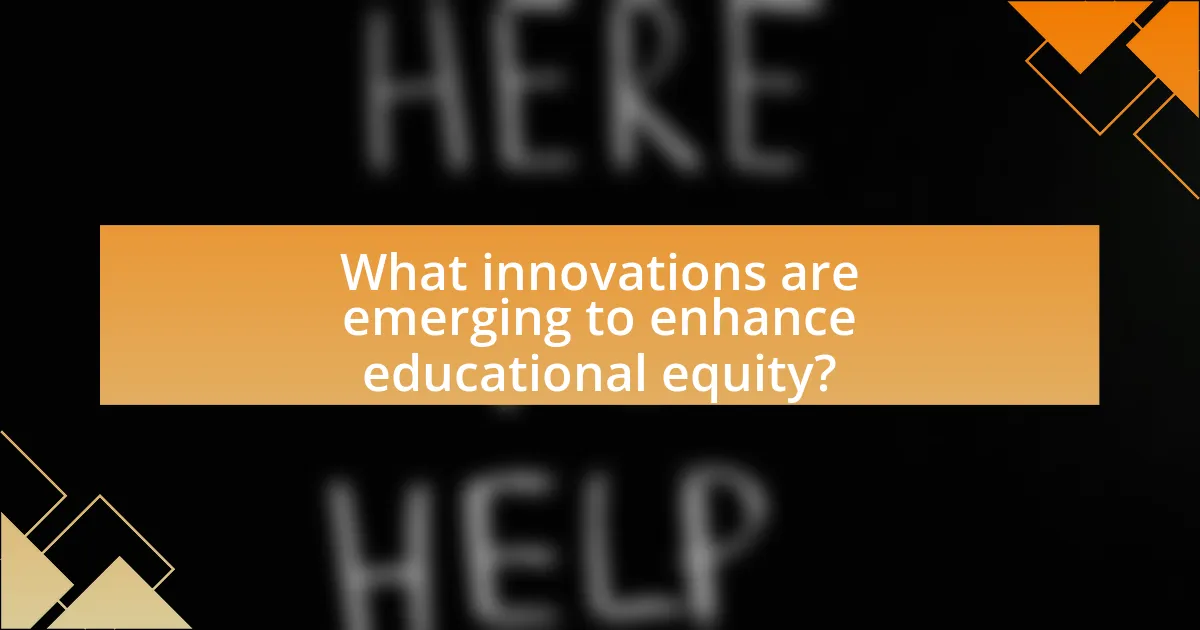
What innovations are emerging to enhance educational equity?
Innovations enhancing educational equity include adaptive learning technologies, online learning platforms, and community-based educational initiatives. Adaptive learning technologies personalize education by adjusting content and pacing to meet individual student needs, thereby addressing diverse learning styles and backgrounds. Online learning platforms, such as Coursera and Khan Academy, provide access to quality educational resources for underserved populations, breaking geographical and financial barriers. Community-based educational initiatives, like mentorship programs and after-school tutoring, foster local engagement and support, ensuring that students from disadvantaged backgrounds receive the guidance and resources necessary for academic success. These innovations collectively aim to create a more equitable educational landscape by addressing systemic barriers and promoting inclusive access to learning opportunities.
How are new teaching methodologies contributing to educational equity?
New teaching methodologies are contributing to educational equity by personalizing learning experiences and accommodating diverse learning styles. These methodologies, such as differentiated instruction and project-based learning, allow educators to tailor their approaches to meet the unique needs of each student, thereby reducing barriers to learning. For instance, research from the Bill & Melinda Gates Foundation indicates that personalized learning can significantly improve student engagement and achievement, particularly among underrepresented groups. By leveraging technology and collaborative learning environments, these methodologies foster inclusivity and ensure that all students have access to quality education, ultimately promoting equity in educational outcomes.
What are the benefits of personalized learning approaches?
Personalized learning approaches enhance student engagement and improve academic outcomes by tailoring education to individual needs and learning styles. This method allows educators to identify specific strengths and weaknesses of each student, enabling targeted instruction that fosters deeper understanding and retention of material. Research indicates that personalized learning can lead to increased motivation and higher achievement levels; for instance, a study by the Bill & Melinda Gates Foundation found that schools implementing personalized learning saw significant gains in student performance, particularly among disadvantaged populations. By addressing diverse learning preferences, personalized learning promotes equity in education, ensuring that all students have the opportunity to succeed.
How do collaborative learning environments promote equity?
Collaborative learning environments promote equity by fostering inclusive participation and diverse perspectives among students. These environments encourage students from various backgrounds to engage in teamwork, which helps to break down social barriers and reduces disparities in learning opportunities. Research indicates that collaborative learning can enhance academic achievement for underrepresented groups, as it allows for shared knowledge and peer support, leading to improved outcomes. For instance, a study published in the “Journal of Educational Psychology” by Johnson and Johnson (2014) found that cooperative learning strategies significantly increased the performance of students from disadvantaged backgrounds, demonstrating that collaboration can effectively level the playing field in educational settings.
What technological advancements are driving educational equity?
Technological advancements driving educational equity include online learning platforms, adaptive learning technologies, and mobile access to educational resources. Online learning platforms, such as Coursera and Khan Academy, provide access to high-quality educational materials for students regardless of their geographical location, thereby reducing barriers to education. Adaptive learning technologies, like DreamBox and Smart Sparrow, personalize learning experiences based on individual student needs, ensuring that all learners can progress at their own pace. Additionally, mobile access through smartphones and tablets allows students in underserved communities to engage with educational content, facilitating learning outside traditional classroom settings. According to a report by the Bill & Melinda Gates Foundation, these technologies have significantly increased access to education for marginalized groups, demonstrating their role in promoting educational equity.
How can artificial intelligence improve access to educational resources?
Artificial intelligence can improve access to educational resources by personalizing learning experiences and providing adaptive learning technologies. These AI-driven systems analyze individual student performance and learning styles, enabling tailored educational content that meets specific needs. For instance, platforms like Khan Academy utilize AI algorithms to recommend resources based on a student’s progress, ensuring that learners receive appropriate materials that enhance their understanding. Additionally, AI can facilitate language translation and accessibility features, making educational resources available to non-native speakers and students with disabilities, thereby broadening access to quality education.
What role do online learning platforms play in bridging equity gaps?
Online learning platforms play a crucial role in bridging equity gaps by providing accessible educational resources to diverse populations. These platforms enable learners from various socio-economic backgrounds to access high-quality content, often at little to no cost, which helps to level the playing field. For instance, a report by the Brookings Institution highlights that online education can reduce barriers related to geography and financial constraints, allowing students in underserved areas to gain skills and knowledge that were previously out of reach. Additionally, platforms often offer flexible learning schedules, accommodating those who may have work or family obligations, further promoting inclusivity in education.
What community initiatives are fostering educational equity?
Community initiatives fostering educational equity include programs like after-school tutoring, mentorship schemes, and scholarship funds aimed at underrepresented students. For instance, the “Say Yes to Education” initiative provides comprehensive support, including tutoring and college scholarships, to students in low-income areas, significantly increasing their college enrollment rates. Additionally, organizations like “Teach For America” work to place educators in underserved communities, addressing teacher shortages and improving educational outcomes. These initiatives are backed by research showing that targeted support can close achievement gaps and enhance access to quality education for marginalized groups.
How do mentorship programs support underrepresented students?
Mentorship programs support underrepresented students by providing guidance, resources, and networking opportunities that enhance their educational and professional development. These programs often connect students with mentors who share similar backgrounds or experiences, fostering a sense of belonging and understanding. Research indicates that students with mentors are more likely to pursue higher education, achieve academic success, and develop essential skills. For instance, a study by the National Mentoring Partnership found that mentored youth are 55% more likely to enroll in college and 78% more likely to volunteer regularly in their communities, demonstrating the significant impact of mentorship on educational equity and access.
What impact do community partnerships have on local educational equity efforts?
Community partnerships significantly enhance local educational equity efforts by providing resources, support, and advocacy that address systemic disparities. These collaborations often involve schools, local businesses, non-profits, and community organizations working together to create programs that target under-resourced areas, thereby improving access to quality education. For instance, research from the National Education Association indicates that schools with strong community partnerships report higher student engagement and improved academic outcomes, particularly among marginalized groups. This evidence underscores the effectiveness of community partnerships in fostering an equitable educational landscape.
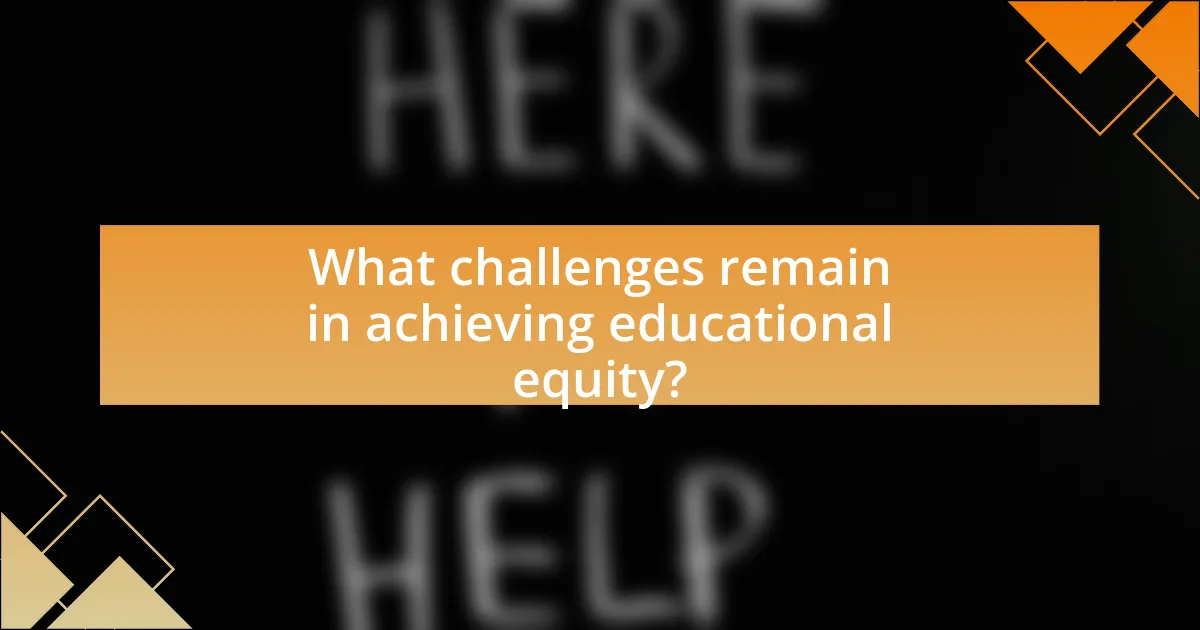
What challenges remain in achieving educational equity?
Challenges in achieving educational equity include systemic disparities in funding, access to quality resources, and socio-economic barriers. For instance, schools in low-income areas often receive significantly less funding than those in affluent neighborhoods, leading to inadequate facilities and fewer educational opportunities. According to the U.S. Department of Education, schools serving predominantly low-income students receive about $1,200 less per student than those serving wealthier populations. Additionally, socio-economic factors such as parental education levels and community support systems further exacerbate these inequities, limiting students’ access to advanced coursework and extracurricular activities. These persistent challenges hinder the goal of providing equal educational opportunities for all students, regardless of their background.
What barriers do marginalized groups face in accessing quality education?
Marginalized groups face significant barriers in accessing quality education, including socioeconomic disparities, systemic discrimination, and inadequate resources. Socioeconomic disparities often result in limited access to educational materials, technology, and safe learning environments, which are crucial for effective education. Systemic discrimination, whether based on race, ethnicity, or disability, can lead to biased treatment within educational institutions, further hindering academic success. Additionally, inadequate resources, such as poorly funded schools and lack of qualified teachers, disproportionately affect marginalized communities, resulting in lower educational outcomes. According to the National Center for Education Statistics, students from low-income families are less likely to graduate high school compared to their more affluent peers, highlighting the impact of these barriers on educational equity.
How does socioeconomic status affect educational opportunities?
Socioeconomic status significantly affects educational opportunities by influencing access to resources, quality of schools, and support systems. Students from higher socioeconomic backgrounds typically have access to better-funded schools, advanced coursework, and extracurricular activities, which enhance their educational experiences. In contrast, those from lower socioeconomic backgrounds often attend underfunded schools with fewer resources, leading to disparities in educational quality. Research by the National Center for Education Statistics indicates that students from low-income families are less likely to graduate from high school and pursue higher education compared to their wealthier peers. This gap in educational attainment is further exacerbated by factors such as limited access to technology, tutoring, and a conducive learning environment at home.
What systemic issues perpetuate educational inequities?
Systemic issues that perpetuate educational inequities include inadequate funding, discriminatory policies, and socio-economic disparities. Inadequate funding often leads to resource shortages in schools serving low-income communities, resulting in larger class sizes and fewer educational materials. Discriminatory policies, such as those that disproportionately affect minority students, contribute to unequal access to advanced coursework and extracurricular opportunities. Socio-economic disparities further exacerbate these issues, as students from lower-income families may lack access to technology and support systems that facilitate learning. According to the National Center for Education Statistics, schools in high-poverty areas receive about $1,200 less per student than those in low-poverty areas, highlighting the financial inequities that exist within the education system.
How can stakeholders address these challenges effectively?
Stakeholders can address challenges in educational equity effectively by implementing targeted policies and collaborative initiatives. For instance, local governments can allocate resources to underfunded schools, ensuring equitable access to quality education. Research from the National Center for Education Statistics indicates that equitable funding can significantly improve student outcomes, particularly in disadvantaged communities. Additionally, stakeholders can foster partnerships between schools, community organizations, and businesses to create mentorship programs and internship opportunities, enhancing real-world learning experiences. Such collaborative efforts have been shown to increase student engagement and success rates, as evidenced by programs like the Harlem Children’s Zone, which has demonstrated improved educational outcomes through comprehensive community support.
What strategies can schools implement to promote inclusivity?
Schools can implement strategies such as differentiated instruction, inclusive curricula, and fostering a supportive school culture to promote inclusivity. Differentiated instruction tailors teaching methods to accommodate diverse learning styles and abilities, ensuring that all students can engage with the material effectively. Inclusive curricula incorporate diverse perspectives and histories, which helps all students feel represented and valued. Additionally, fostering a supportive school culture involves training staff on cultural competency and creating safe spaces for dialogue, which can enhance understanding and acceptance among students. Research indicates that schools employing these strategies see improved academic outcomes and social cohesion among students, demonstrating their effectiveness in promoting inclusivity.
How can policymakers create more equitable educational systems?
Policymakers can create more equitable educational systems by implementing targeted funding strategies that address disparities in resources among schools. For instance, research from the National Center for Education Statistics indicates that schools in low-income areas receive significantly less funding than those in affluent neighborhoods, leading to unequal access to quality education. By reallocating funds based on student needs and ensuring that underfunded schools receive adequate financial support, policymakers can help level the playing field. Additionally, establishing inclusive curricula that reflect diverse cultures and experiences can foster a more equitable learning environment, as studies show that students perform better when they see their identities represented in their education.
What are the best practices for fostering educational equity in the future?
The best practices for fostering educational equity in the future include implementing inclusive curricula, ensuring equitable funding, and utilizing technology to enhance access. Inclusive curricula that reflect diverse perspectives can engage all students and promote a sense of belonging. Equitable funding is essential, as research shows that schools in low-income areas often receive significantly less funding, which impacts resources and opportunities available to students. For instance, a report by the Education Trust highlights that schools serving predominantly students of color receive about $23 billion less than those serving mostly white students. Additionally, leveraging technology can bridge gaps in access to educational resources, as seen during the COVID-19 pandemic when online learning platforms provided alternative means for students to continue their education. These practices collectively contribute to a more equitable educational landscape.
How can educators adapt their practices to support diverse learners?
Educators can adapt their practices to support diverse learners by implementing differentiated instruction tailored to individual learning needs. This approach involves assessing students’ strengths, weaknesses, and interests to provide personalized learning experiences. Research indicates that differentiated instruction can lead to improved academic outcomes, as evidenced by a study published in the “Journal of Educational Psychology,” which found that students in differentiated classrooms showed higher engagement and achievement levels compared to those in traditional settings. Additionally, incorporating culturally responsive teaching strategies helps educators connect with students from various backgrounds, fostering an inclusive environment that values diversity.
What role does continuous professional development play in promoting equity?
Continuous professional development (CPD) plays a crucial role in promoting equity by equipping educators with the skills and knowledge necessary to address diverse student needs effectively. CPD fosters an inclusive educational environment by enhancing teachers’ cultural competence, enabling them to understand and respond to the unique challenges faced by marginalized groups. Research indicates that when educators engage in ongoing training focused on equity, such as the study by Darling-Hammond et al. (2017) published in “Educational Policy,” student outcomes improve, particularly for underrepresented populations. This correlation demonstrates that CPD not only empowers educators but also directly contributes to closing achievement gaps, thereby promoting equity in education.
